We live in the age of “consumer-centric healthcare.” Patients no longer simply pay for medical services; they’re trading loyalty for a seamless experience.
If your medical care is excellent, but your reception is unreachable, you have a patient experience problem. It’s not just about HCAHPS scores or quality ratings; it’s about how a vulnerable person feels during their treatment.
This guide covers the fundamentals of patient experience (PX), how to measure it, and 10 practical strategies for improving it.
What Is Patient Experience? (vs. Patient Satisfaction)
Patient experience encompasses every interaction a patient has with the healthcare system, including care provided by health insurance companies, doctors, nurses, and hospital staff. It helps you determine whether everything went as planned. (e.g., Did you get an appointment quickly? Did the doctor explain the side effects?)
Patient satisfaction is subjective. It focuses on whether the experience meets patients’ expectations.
Let’s visualize the difference. Imagine a patient is in the hospital for a week and needs daily blood draws.
| Scenario A: The Task Approach | Scenario B: The Experience Approach |
|---|---|
| A nurse walks in, checks the ID band, and says, “I need to take your blood.” | A nurse walks in, smiles, and says, “Hi, I’m Amy. I’m here for your daily check.” |
| Shes efficient but silent. She frowns while finding the vein. | She asks, “How did you sleep?” distracting the patient while she locates the vein. |
| She jabs the needle, draws the blood, and leaves immediately. | She says, “I’ve been doing this for 10 years, they call me ‘Gentle Amy’.” She draws the blood painlessly. |
| Result: The job got done. The patient felt like a pin cushion. | Result: The job got done. The patient felt cared for and safe. |
In both scenarios, the clinical outcome (blood drawn) was identical. But in Scenario B, the patient’s anxiety was managed. That is the power of a positive patient experience.
Nextiva’s Healthcare Customers Use AI to Elevate Patient Experience
Get a front-row seat to see how AI and automation are reshaping healthcare: enhancing patient experiences, boosting engagement, and driving efficiency.
Metrics for Measuring Patient Experience
Below are a few metrics healthcare facilities keep track of when observing overall patient experience.
CAHPS and HCAHPS surveys
Consumer Assessment of Healthcare Providers and Systems (CAHPS) and Hospital CAHPS (HCAHPS) are the national standards for measuring patient experience in ambulatory and hospital settings.
These patient experience surveys have standardized questions to ensure consistent patient experience data collection across organizations. Qualified vendors administer these surveys via phone or mail. The results are reported publicly, helping healthcare facilities compare their performance against national benchmarks.
Here’s an example of questions asked in an HCAHPS survey:
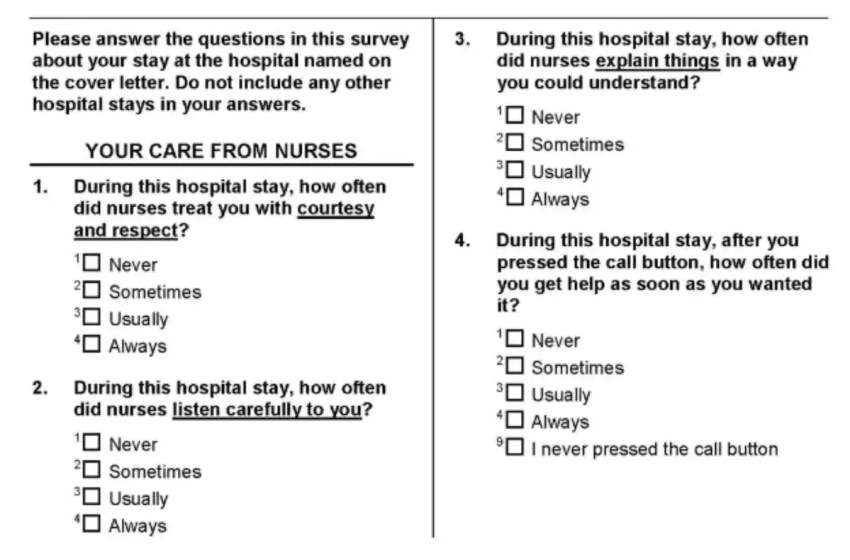
These surveys aren’t just for measurement; they also show gaps in experience, which, when filled, drive quality patient safety and care.
HCAHPS, often called H-caps, was developed by the Centers for Medicare & Medicaid Services (CMS) and the Agency for Healthcare Research and Quality in the early 2000s. It was implemented in 2006. The responses are aggregated into 10 publicly reported measures, usually reported as top-box percentages. Benchmarking is robust here.
For example, in a CMS report from mid-2024, the national top box score was:
- 80% for nurse and doctor communication
- 67% for staff responsiveness
- 70% for “definitely yes” on recommending the hospital
Operational KPIs linked to patient experience
Beyond surveys, there are various operational KPIs that healthcare professionals keep track of to understand the performance of day-to-day functions.
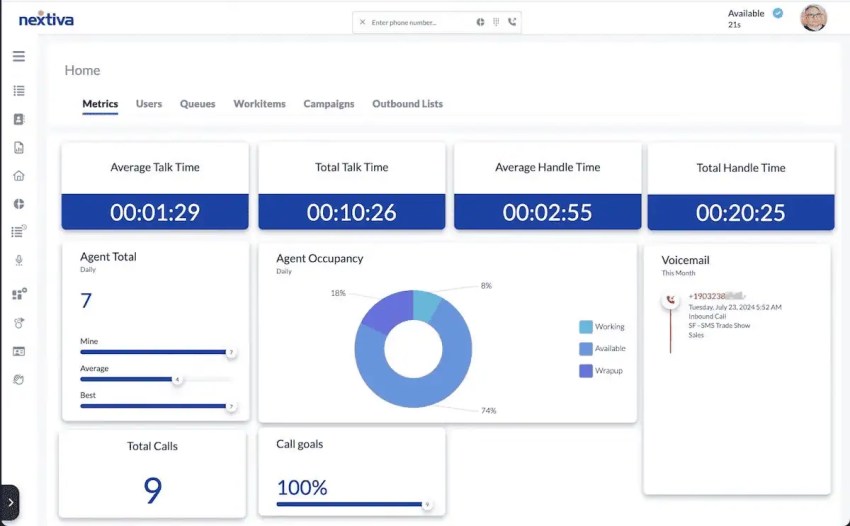
These KPIs are scattered across different phases of a patient’s journey, for example:
- First call resolution is a measure of the percentage of patient inquiries (calls, messages, etc.) resolved on the first contact without the need for repeat calls or hand-offs. Healthcare call centers solve about 71% of patient issues on the first call, which shows there’s room to improve how quickly and effectively patient questions are answered.
- Average handle time (AHT) is the average duration of a customer service interaction, for example, the time a patient spends on the phone with a scheduling agent or IT help desk, including hold time and wrap-up. AHT reflects efficiency in addressing patient needs. The goal here is to balance speed with care. It’s about 6.6 minutes for a healthcare contact center.
- Wait time is a universal pain point in healthcare. Metrics include time in waiting rooms for clinic visits, ER, etc., time on hold on the phone, and virtual queue time for telehealth visits.
- Follow-up turnaround time is how quickly patients receive results and follow-up instructions from labs or imaging facilities. The shorter the time, the better the patient’s experience.
- Missed appointments and no-show rates are both operational inefficiencies and signals about patient engagement and access. For context, no-show rates in the U.S. vary widely: from as low as 5% in some primary care offices up to 30% or more in certain outpatient specialties.
Ontrak Health uses Nextiva as its cloud-based contact center solution to monitor its operational KPIs.

“Over the years, we have seen continuous growth. It seems like every month there is a new release [from Nextiva] with new features we can implement, and it not only helps us reach our members, but it also helps us streamline processes for our employees.
Because it’s so super user-friendly, it’s easy to implement something new … It gives us more insight into other ways to continue evolving.”~ Mandi Thomas
Qualitative feedback and sentiment data
Qualitative feedback includes survey comments, free-text narratives, social media posts, and call center recordings. Such data captures the why behind the numbers. Many healthcare facilities employ quick feedback requests with post-visit and post-call surveys within 24 hours of a clinic visit.
Some health systems use proprietary post-visit surveys, administered by vendors like Press Ganey, in addition to the standardized CAHPS. Likewise, after a call to a customer service line, an automated interactive voice response (IVR) system can invite the caller to rate the health care experience or answer, “Was your issue resolved? Press 1 for yes, 2 for no,” which is followed by an opportunity to leave a voicemail comment. These on-the-spot surveys offer qualitative snippets that keep fueling the continuous feedback loop.
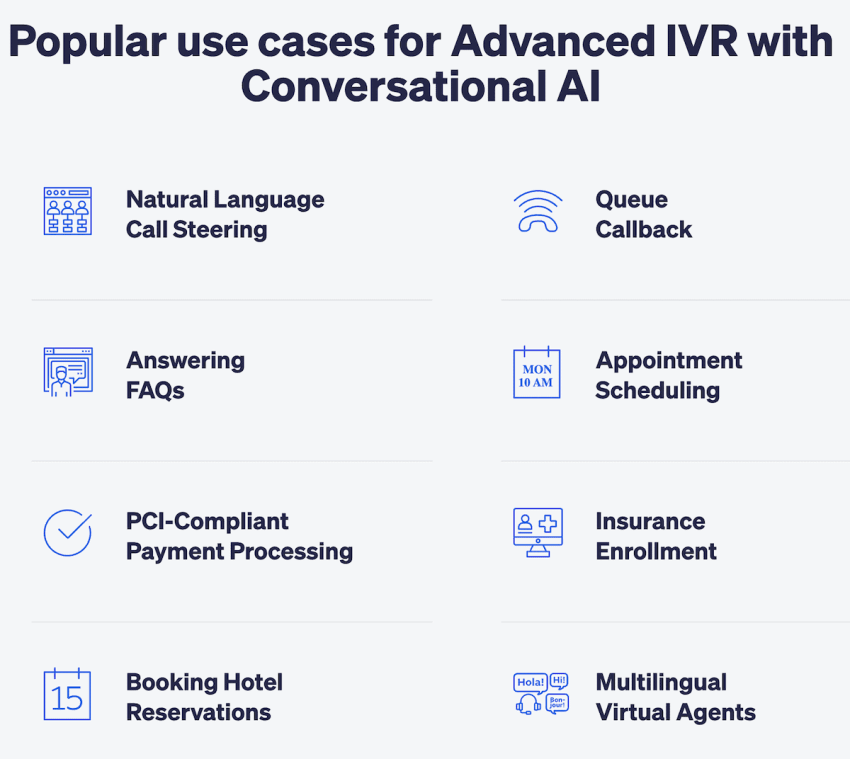
Healthcare CX tools use AI algorithms to analyze sentiments in these qualitative snippets and determine the overall sentiment. These tools are well-tuned to pick out patient sentiments from call center conversations, reviews, and social mentions.
10 High-Impact Strategies to Improve Patient Experience
Below are some high-impact strategies that can help improve patient experience for organizations.
1. Improve scheduling and access to care
Experience delivery starts when a patient contacts a medical facility. Some contact for regular appointments, while others expect urgent and priority care for critical issues. You need to serve both situations well.
Dr. Bruce A. Scott, AMA President, says, “It’s becoming increasingly challenging to access a physician. It’s almost at a crisis level.” As a responsible healthcare facility, you need to address this.
Implement open-access or same-day scheduling for such urgent issues. This shows you care, and when it matches how you deal with such cases, it translates into experience.
When receiving regular care, give customers the flexibility to self-schedule through IVR, chat, or patient portals. Make the customer’s experience as flexible as possible.
2. Make communication human and clear
“A good scalpel makes a better surgeon. Good communication makes a better doctor.” Dr. Josh Umbehr notes the importance of clear communication in an article on TechCrunch.
According to statistics, up to 80% of the information patients receive in a clinical visit is immediately forgotten. Doctors and nurses must ensure patients follow their medical advice.
Use methods like “teach-back” to ensure patients understand the care you’re offering. Offer updates during long wait periods or call hold times. Giving patient summaries or handouts is best to ensure information is documented.

Most importantly, train your staff to listen. It’s the most significant yet overlooked part of communication in any medical institution. Research shows that patients, on average, get only about 11 seconds to explain their concerns before being interrupted by physicians.
3. Train all staff on empathy and de-escalation
Your staff needs to empathize with customers, and this empathy must be ingrained in their behavior, caregiving, and all patient interactions with customers within and outside of your facility.
Dr. Peter Pronovost says, “Patients don’t care how much we know until they know how much we care.” This is highly relevant in the context of modern healthcare initiatives. Show patients that you care by displaying the empathy expected of you. This is what a patient expects.
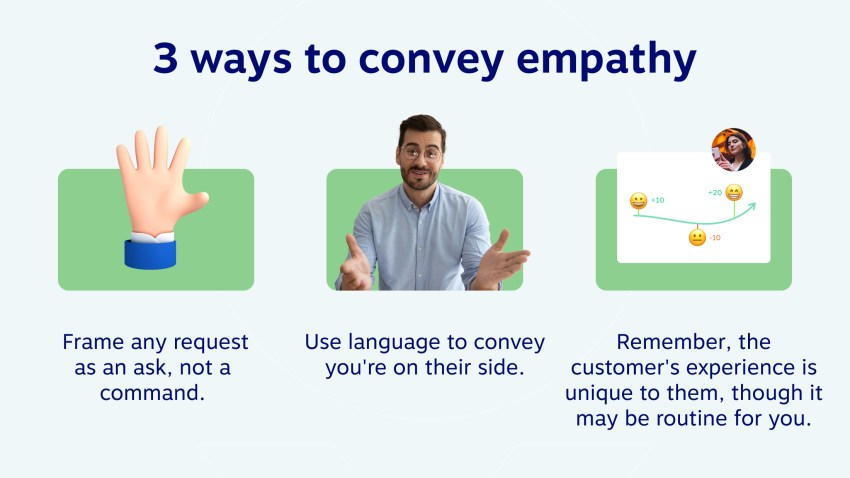
If a patient shows signs of frustration, coach your team on responding empathetically. To do this, hold regular patient experience huddles to review wins and areas of concern.
Check out healthcare call center best practices to coach your team effectively.
4. Build a culture of follow-up and accountability
Electronic health records (EHR) are used to call patients back about labs or open questions. If some patients miss an appointment, don’t show up, or simply reschedule, treat them respectfully and understand barriers. Bring empathy into these interactions, as patients might come back later, but they’ll carry how you made them feel for a long time.
If your doctors or caregivers make commitments, make sure they follow through. For example, if you say, “I’ll call you in a week to check on that,” you must adhere to what you promised.
5. Use digital tools to empower patients
In one survey, 41% of patients said they would switch providers over a poor digital experience. This could be difficulty with online forms, a lack of online appointment scheduling or bill pay, or other factors, and one in five have already done so.
Delivering a decent digital experience has become indispensable. To do this, you need self-service solutions like IVR, mobile apps, or portals to check results or reschedule.

Even a healthcare CRM can help you provide adequate care. Communication systems, portals, and apps integrate with a healthcare CRM, giving you a unified platform to manage all patient communication.
See if you can automate follow-ups a few days after a patient visits your facility. Give patients options to get a call back and help them avoid being on hold.
6. Make care coordination seamless
Patients frequently navigate multiple providers, departments, and care settings, and they feel the pain when care is not coordinated. In a survey of over 1,000 patients, 42% spent six minutes or more recounting their medical history at every appointment. The data isn’t integrated, making this a significant challenge in streamlining a patient’s experience across different medical facilities.
Matt Hollingsworth, the CEO of Carta Healthcare, says, “One thing that I think is completely unconscionable is that you can’t share your data with other care providers when you want to get better care, and people get frustrated about that constantly.”
Implement an interoperable EHR system and set a “tell it once” policy to ensure seamless coordination. This will alleviate the burden. Some leading organizations assign care navigators or case managers to help coordinate appointments, especially for patients with complex needs. These navigators help schedule care across specialties, remind patients of follow-ups, and serve as a single point of contact. Overall, ensure that the patients don’t have to repeat their story at every touchpoint.
7. Incorporate shared decision-making
Shared decision-making (SDM) allows physicians and patients to make health decisions together, considering the best medical evidence and the patient’s values and preferences. This collaborative approach leads to more personalized care and higher patient satisfaction:
Surveys show that many patients desire greater involvement in their care decisions. In England’s 2022 GP Patient Survey (with over 700,000 respondents), 44.6% of patients said they wanted more participation in healthcare decisions than they currently have. This was the highest level since this was tracked, and up significantly from prior years.
This research also observed that when patients engage in shared decision-making, outcomes improve. Patients are more likely to adhere to chosen treatment plans, have less regret about their decisions, and report higher satisfaction.
However, there’s a difference in the extent to which patients want to participate in decision-making. Some want to delegate their decisions to the doctor, while others like to evaluate all the options in detail. A population-based study noted that about 20% of people prefer a more clinician-directed approach, but the majority appreciate at least some discussion of options. Personalizing the decision-making approach is key.
Lately, some surveys have started measuring SDM. For example, the CAHPS survey asks if doctors involve patients in decisions as much as they would like.
8. Proactively address health literacy
Health literacy is the ability for patients to obtain, process, and understand basic health information to make appropriate health decisions. Patient care suffers when they can’t comprehend what’s being explained or struggle with medical forms and instructions. Patients with low health literacy are more likely to feel overwhelmed and dissatisfied.
You must put all written and verbal communication in plain language by default. For example, instead of saying, “You have a benign neoplasm,” say, “You have a non-cancerous tumor.” Or you could say, “Limit salt in your food” instead of “Follow a low-sodium diet.” You get the gist.
The written information you give the patient needs to be at a reading level of 6th grade. This helps most adults understand. If possible, include more visual aids, like an infographic showing how to manage chronic conditions.
9. Create a welcoming physical and digital environment
The environment significantly influences how patients feel about their healthcare experience. A welcoming atmosphere is clean, comfortable, easy to navigate, and designed with the patient’s perspective in mind.
Cleanliness is not just about infection control; it affects patient dignity and comfort. Similarly, noise levels matter. Excess noise from alarms, loud staff conversations, and other patients are common complaints and can hinder rest and recovery.
First impressions count. A difficult-to-find clinic with a cluttered, uninviting waiting room and an unfriendly front desk encounter may already put a patient in a negative mindset before any clinical care occurs. On the other hand, a thoughtfully designed environment, both in-person and online, can reduce patient anxiety while building trust and confidence.
You can create a more hospitable environment by:
- Regularly rounding in waiting areas to ask patients if they need anything and offering updates if there’s a delay.
- Avoiding rude signage and using more compassionate language is particularly important in a caregiving facility.
- Providing a seamless digital experience on a mobile app or web browser. This pays off in patient loyalty and positive word-of-mouth reinforcement.
10. Use feedback for continuous improvement
According to an Accenture report, around one in five patients switched healthcare providers in 2023, and 89% of people said they did so because the facility was hard to do business with.
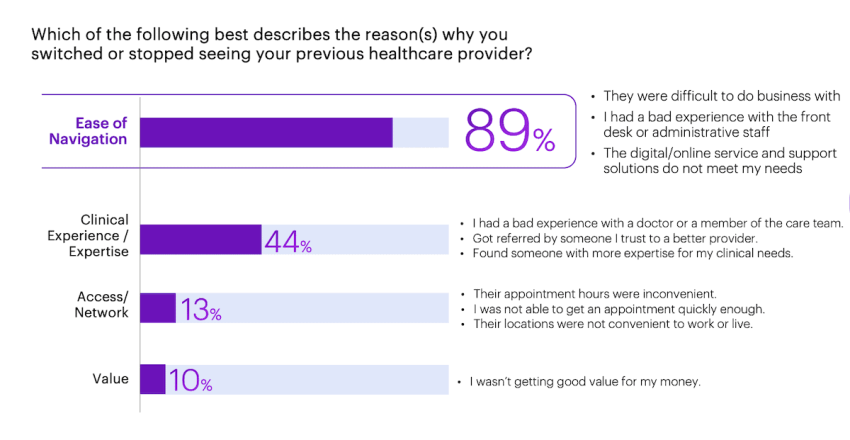
Patient concerns might keep changing, and you, as a facility, need to keep yourself updated with the latest opinions. Healthcare organizations that excel in patient experience treat it as an ongoing quality improvement endeavor. They systematically collect patient feedback and, crucially, act on it. Closing the feedback loop visibly demonstrates to patients that their voices matter and drives continuous service improvements.
You can gather feedback through post-visit or post-call surveys while consistently monitoring patient sentiment and recurring complaints. Some hospitals hold annual patient experience fairs or reward programs to celebrate units that improved scores or solved persistent problems, ensuring a positive patient experience.
Nextiva’s Healthcare Customers Use AI to Elevate Patient Experience
Get a front-row seat to see how AI and automation are reshaping healthcare: enhancing patient experiences, boosting engagement, and driving efficiency.
How Technology Improves Patient Experience
Communication is a major part of caregiving. It covers how you communicate, its clarity and simplicity, and how well the patient understands and retains that communication.
Unified communications platforms, such as Nextiva, bridge those gaps by providing staff with access to patient context and enabling consistent messaging across all channels. They help your staff be on the same page while dealing with customers, digitally or in person, minimizing miscommunication and patients repeating themselves.
- Omnichannel support: Let patients text, chat, or call — whatever they prefer. All interactions live in one view.
- EHR integration: When a patient calls, their profile pops up on the screen. The scheduler greets them by name and sees their upcoming appointments instantly.
- Analytics: Track average handle time and abandonment rates to spot staffing shortages before they impact patients.
- Reliability: In healthcare, downtime is a safety issue. Nextiva offers 99.999% uptime reliability.
See how cloud communications streamline the patient journey from appointment to follow-up.

Unify conversations for the ideal patient experience.
Small practices to large healthcare organizations trust Nextiva to manage all their end-to-end patient interactions using our HIPAA-compliant platform.

















 Customer Experience
Customer Experience 








